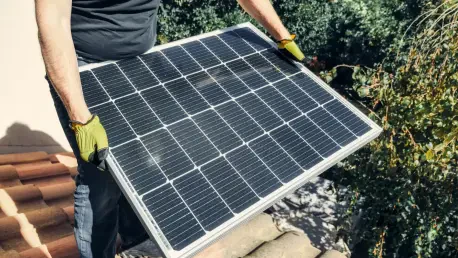Imagine a world where the steel in a finely crafted Swiss watch is forged not by smoky, coal-powered furnaces, but by the clean, boundless energy of the sun—a vision that has now become reality through the groundbreaking work of Panatere, a Swiss company based in La Chaux-de-Fonds, which unveiled a revolutionary technology on October 3 of this year. In the heart of Swiss horology in Canton Neuchâtel, Panatere introduced the world’s first industrial solar furnaces designed to recycle steel offcuts from the watchmaking industry. This pioneering technology harnesses concentrated sunlight to produce “green steel” with a carbon footprint so low it’s almost negligible, marking a seismic shift in sustainable manufacturing. This isn’t merely a technological feat; it’s a bold statement for high-precision industries such as watchmaking, medical instruments, and aeronautics, which are increasingly under pressure to reduce environmental impact. By transforming industrial waste into premium materials using renewable energy, Panatere is setting a new benchmark for sustainability while championing the principles of a circular economy. The implications of this innovation ripple far beyond Switzerland’s borders, offering a glimpse into a future where heavy industries can operate without the burden of massive carbon emissions. How does this solar-powered system work, and what does it mean for the future of luxury goods and industrial practices? Exploring the depths of this development reveals a story of ingenuity, collaboration, and a relentless drive toward a greener tomorrow.
Harnessing the Sun for Industrial Innovation
Panatere’s solar furnace technology stands as a testament to human ingenuity in the fight against climate change, utilizing the power of sunlight to achieve what was once thought impossible in steel production. The system employs 500 concave mirrors alongside a heliostat to focus solar rays onto a crucible, heating metals like steel, stainless steel, and titanium to temperatures as high as 2,000°C. In just 1.5 hours, these materials are melted down with zero CO2 emissions—a stark contrast to traditional fossil fuel-based methods that heavily contribute to greenhouse gases. What’s more, this process yields a carbon footprint 165 times lower than conventional steelmaking, making it a revolutionary step toward decarbonization. Protected by two patents, the technology also incorporates advanced alloy sorting processes, ensuring the quality of the recycled materials remains uncompromised. This marks the first industrial application of solar furnaces for metal recycling, distinguishing it from earlier experimental or scientific uses.
The journey to this milestone has been one of persistent innovation, with Panatere refining the concept over a decade of research and development. Key achievements include producing the first solar-melted ingot in France before scaling up to industrial-level furnaces this year. Unlike traditional steel production, which relies on vast energy inputs from non-renewable sources, Panatere’s method leverages a renewable resource that is both abundant and clean. This not only slashes environmental harm but also positions the company as a leader in sustainable industrial practices. As global industries face mounting pressure to meet stringent climate goals, this solar-powered approach offers a viable, scalable solution that could redefine manufacturing standards across multiple sectors.
Building a Circular Economy in Switzerland’s Heartland
At the foundation of Panatere’s mission lies a commitment to the circular economy, a model that prioritizes turning waste into valuable resources rather than discarding it. In Switzerland’s Jura region, a hub for precision industries, the company collects steel and titanium offcuts from local watchmaking, medical, and aeronautical businesses. These scraps, which might otherwise be overlooked, are transformed into high-quality ingots through the power of solar energy. This closed-loop system significantly reduces waste while cutting reliance on imported raw materials, fostering a sustainable cycle of production and reuse. The environmental benefits are clear, but so too is the economic advantage of maximizing resource efficiency in a region known for its meticulous craftsmanship.
This localized recycling effort resonates deeply with Swiss industries that pride themselves on quality and heritage, yet face growing demands for environmental responsibility. Luxury watchmaking brands, in particular, find in Panatere’s green steel a way to maintain their reputation for excellence while embracing sustainability. The initiative also minimizes the carbon footprint associated with transporting raw materials across continents, further enhancing its eco-friendly credentials. By focusing on regional waste streams, Panatere creates a material loop that not only supports local economies but also sets a precedent for other industries to adopt similar practices. This approach could inspire a broader shift toward decentralized, sustainable production models, where communities benefit from both environmental and economic gains.
Elevating Swiss Industries with Sustainable Materials
Swiss watchmaking giants such as Rolex, Omega, and Panerai are among the primary beneficiaries of Panatere’s solar-recycled steel, gaining a powerful tool to bolster their sustainability profiles. In an era where environmentally conscious consumers, particularly younger generations like Gen Z and Millennials, prioritize eco-friendly products, adopting green steel offers a distinct competitive edge. This material allows brands to craft timepieces that embody both timeless elegance and a commitment to the planet, appealing to a demographic that values ethical production. Beyond mere marketing, this shift aligns with global trends pushing luxury sectors to reduce their environmental impact, ensuring these companies remain relevant in a rapidly changing market.
The advantages extend to other high-precision fields, notably medical instrument manufacturing, which is also prominent in the Jura region. For these producers, low-carbon materials align seamlessly with healthcare sector mandates that increasingly emphasize sustainability alongside performance. Utilizing Panatere’s green steel helps meet regulatory expectations and positions these firms as forward-thinking leaders in their field. Conversely, companies that lag in adopting such innovations risk losing market share and damaging their brand reputation as environmental accountability becomes a non-negotiable standard. The ripple effect of this technology challenges traditional players to adapt swiftly or face obsolescence in an industry landscape where sustainability is no longer optional but essential.
Bolstering Supply Chain Resilience
Panatere’s initiative addresses a critical modern concern—supply chain resilience—by producing traceable, recyclable steel directly from local industrial scraps. This approach significantly reduces Switzerland’s dependence on volatile international markets for raw materials, a vulnerability exposed by recent global disruptions. For high-precision industries like watchmaking and medtech, where material quality is paramount, having control over sourcing is invaluable. Panatere’s localized production ensures consistency and transparency, meeting the exacting standards these sectors demand while simultaneously cutting down on the carbon emissions tied to long-distance logistics.
This model of localized manufacturing dovetails with broader trends of reshoring and nearshoring, where countries and companies seek to bring production closer to home for greater stability. By strengthening regional supply chains, Panatere not only enhances Switzerland’s industrial autonomy but also contributes to a reduced environmental footprint through shorter transport routes. The strategic importance of such self-reliance cannot be overstated, especially in a world where geopolitical tensions and economic uncertainties continue to threaten global trade. As a result, this innovation serves as a blueprint for other nations and industries aiming to fortify their own supply networks, proving that sustainability and economic security can go hand in hand in shaping the future of manufacturing.
Inspiring a Global Shift Toward Greener Practices
The significance of Panatere’s solar furnace technology transcends national boundaries, offering a compelling proof of concept for renewable energy in heavy industry. By demonstrating the viability of solar metallurgy for high-value alloys, it paves the way for larger steel producers worldwide to explore similar alternatives to fossil fuel-dependent processes. This comes at a crucial time when regulatory frameworks, such as the EU’s Carbon Border Adjustment Mechanism (CBAM), are imposing tariffs on carbon-intensive imports, pushing industries to adopt cleaner methods. Panatere’s 100% recycled, CO2-free steel positions Swiss exporters advantageously in this shifting landscape, meeting stringent environmental standards with ease.
Moreover, this breakthrough serves as a catalyst for broader industrial transformation, challenging conventional steelmaking to rethink its reliance on high-emission practices. As global demand for sustainable materials grows, driven by both consumer expectations and policy pressures, Panatere’s model could inspire decentralized, solar-powered recycling hubs in sun-rich regions across the globe. The potential for scaling this technology to other metals and sectors hints at a future where renewable energy becomes the backbone of industrial production. While challenges like initial investment costs remain, the long-term benefits of reduced carbon footprints and compliance with international regulations make this an attractive path for forward-looking industries committed to a sustainable future.
A Milestone Born from Collaboration
The success of Panatere’s solar furnace project is not the result of isolated effort but a remarkable collaboration spanning multiple sectors. Under the leadership of CEO Raphaël Broye, the initiative brought together academic expertise from institutions like the École Polytechnique Fédérale de Lausanne (EPFL), governmental backing from entities such as the Federal Office for the Environment, and financial support from partners like the Swiss Climate Foundation. The involvement of 148 scientists and professionals during the prototype phase highlights the depth of collective knowledge and dedication that fueled this innovation, underscoring the power of teamwork in tackling complex challenges.
Industry and public reception to the launch has been overwhelmingly positive, with the technology hailed as a “world first” that bridges Switzerland’s storied tradition of craftsmanship with cutting-edge sustainability. The symbolic exhibition of the first solar steel bar at the International Watch Museum in La Chaux-de-Fonds further cements its cultural and industrial significance. This collaborative triumph illustrates how partnerships between private enterprises, academia, and government can drive transformative change, offering a model for other sustainability projects. It also emphasizes the importance of shared vision in overcoming technical and financial hurdles, ensuring that innovations like solar furnaces can move from concept to reality with impactful results.
Charting the Path Forward for Green Steel
Reflecting on Panatere’s unveiling of industrial solar furnaces on October 3 this year, it’s evident that a pivotal moment in sustainable manufacturing unfolded in La Chaux-de-Fonds. This technology, which recycles steel offcuts using solar power, achieved a near-zero carbon footprint and exemplified circular economy principles for Swiss watchmaking and related industries. The collaborative spirit behind the project, coupled with its alignment with global decarbonization trends, positioned it as a landmark achievement that challenged conventional industrial norms.
Looking ahead, the focus should be on scaling this innovation to meet ambitious production targets, such as reaching 1,000 tons annually by 2028, while addressing challenges like solar intermittency through energy storage solutions. Exploring applications for other strategic metals and potentially licensing the technology to sun-rich regions could amplify its global impact. Stakeholders across industries should take note, investing in similar renewable solutions and fostering partnerships to replicate this model. Panatere’s journey serves as an invitation to rethink manufacturing’s environmental toll, urging a collective push toward integrating clean energy into heavy industry for a more sustainable and resilient future.









